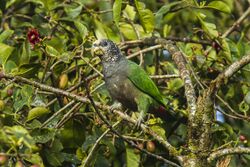Biology:White-capped parrot
| White-capped parrot | |
|---|---|

| |
| Scientific classification | |
| Domain: | Eukaryota |
| Kingdom: | Animalia |
| Phylum: | Chordata |
| Class: | Aves |
| Order: | Psittaciformes |
| Family: | Psittacidae |
| Genus: | Pionus |
| Species: | P. seniloides
|
| Binomial name | |
| Pionus seniloides (Massena & Souancé, 1854)
| |
| Synonyms | |
|
Speckle-faced parrot (White-capped), P. tumultuosus selinoides | |
The white-capped parrot (Pionus seniloides) or white-capped pionus is a species of bird in subfamily Arinae of the family Psittacidae, the African and New World parrots. It is found in Colombia, Ecuador, Peru, and Venezuela.[3]
Taxonomy and systematics
The white-capped parrot's taxonomy has not been settled. The International Ornithological Committee and BirdLife International's Handbook of the Birds of the World consider it to be a full species.[3][4] The South American Classification Committee of the American Ornithological Society (SACC) and the Clements taxonomy treat it and the plum-crowned parrot (P. tumultuosus) as subspecies of the speckle-faced parrot under the binomial P. tumultuosus.[5][6] The SACC declined to split the speckle-faced in 2005 but recognizes that a 2007 study suggests that the split is valid.[7][8][5]
Description
The white-capped parrot is 28 to 30 cm (11 to 12 in) long and weighs about 229 g (8.1 oz). The adult's forehead is white, sometimes with some scattered pink feathers. Their crown, the rest of their face, their throat and their breast are dusky violet or dull purple with plum pink flecks. Their back, wings, and belly are green. Their undertail coverts and the base of their tail are red; the rest of their tail is green with some blue on the outer feathers. Their bill is pale yellowish horn-colored, their iris dark with whitish skin around it, and their legs and feet gray.[9][10]
Distribution and habitat
The white-capped parrot is found from western Venezuela through Colombia's Eastern Andes and both slopes of the Andes in Ecuador into northwestern Peru. It inhabits the canopy and edges of subtropical and temperate forest at elevations between 1,500 and 3,200 m (4,900 and 10,500 ft).[9][10][11]
Behavior
Movement
The white-capped parrot is highly nomadic. It "does not seem to be resident anywhere" and may make seasonal elevational movements.[10]
Feeding
Little is known about the white-capped parrot's foraging behavior or diet. It is known to feed on fruits; those of Turpinia paniculata and members of family Clusiaceae have been identified.[9]
Breeding
The white-capped parrot is thought to breed in November and December. Its breeding biology in the wild is not known; in captivity its clutch size is four eggs and the incubation period is about 26 days. In the wild it is assumed to nest in tree cavities like others of its genus.[9]
Vocalization
The white-capped parrot's calls have been described as resembling those of Aratinga parakeets, for instance "kreeyah-kreeyah-kreeyahkreeyah". It makes these calls both in flight and when perched.[10]
Status
The IUCN has assessed the white-capped parrot as being of Least Concern. It has a large range but its population size is not known and is believed to be decreasing. No immediate threats have been identified.[1] It is considered uncommon.[10][11]
References
- ↑ 1.0 1.1 BirdLife International (2016). "White-capped Parrot Pionus seniloides". IUCN Red List of Threatened Species 2016: e.T22731587A95035869. doi:10.2305/IUCN.UK.2016-3.RLTS.T22731587A95035869.en. https://www.iucnredlist.org/species/22731587/95035869. Retrieved 27 February 2023.
- ↑ "Appendices | CITES". https://cites.org/eng/app/appendices.php.
- ↑ 3.0 3.1 "Parrots, cockatoos". January 2023. https://www.worldbirdnames.org/new/bow/parrots/.
- ↑ HBW and BirdLife International (2022) Handbook of the Birds of the World and BirdLife International digital checklist of the birds of the world. Version 7. Available at: http://datazone.birdlife.org/userfiles/file/Species/Taxonomy/HBW-BirdLife_Checklist_v7_Dec22.zip retrieved December 13, 2022
- ↑ 5.0 5.1 Remsen, J. V., Jr., J. I. Areta, E. Bonaccorso, S. Claramunt, A. Jaramillo, D. F. Lane, J. F. Pacheco, M. B. Robbins, F. G. Stiles, and K. J. Zimmer. Version 30 January 2023. A classification of the bird species of South America. American Ornithological Society. https://www.museum.lsu.edu/~Remsen/SACCBaseline.htm retrieved January 30, 2023
- ↑ Clements, J. F., T. S. Schulenberg, M. J. Iliff, T. A. Fredericks, J. A. Gerbracht, D. Lepage, S. M. Billerman, B. L. Sullivan, and C. L. Wood. 2022. The eBird/Clements checklist of birds of the world: v2022. Downloaded from https://www.birds.cornell.edu/clementschecklist/download/ retrieved November 10, 2022
- ↑ Penhallurick, John (May 2005). "Split Pionus seniloides from Pionus tumultuosus". South American Classification Committee. https://www.museum.lsu.edu/~Remsen/SACCprop176.htm.
- ↑ Ribas, C.C.; Moyle, R.G.; Miyaki, C.Y.; Cracraft, J. (2007). "The assembly of montane biotas: linking Andean tectonics and climate oscillations to independent regimes of diversification in Pionus parrots". Proceedings of the Royal Society B 274 (1624): 2399–2408. doi:10.1098/rspb.2007.0613. PMID 17686731.
- ↑ 9.0 9.1 9.2 9.3 Collar, N., J. del Hoyo, P. F. D. Boesman, G. M. Kirwan, and A. Bonan (2022). Speckle-faced Parrot (Pionus tumultuosus), version 1.1. In Birds of the World (B. K. Keeney, Editor). Cornell Lab of Ornithology, Ithaca, NY, USA. https://doi.org/10.2173/bow.spfpar1.01.1 retrieved February 27, 2023
- ↑ 10.0 10.1 10.2 10.3 10.4 Ridgely, Robert S.; Greenfield, Paul J. (2001). The Birds of Ecuador: Field Guide. II. Ithaca: Cornell University Press. pp. 198–199. ISBN 978-0-8014-8721-7.
- ↑ 11.0 11.1 McMullan, Miles; Donegan, Thomas M.; Quevedo, Alonso (2010). Field Guide to the Birds of Colombia. Bogotá: Fundación ProAves. pp. 65. ISBN 978-0-9827615-0-2.
Wikidata ☰ Q2689101 entry
 |


